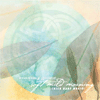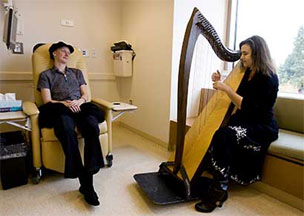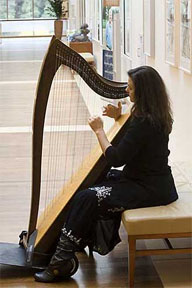 |
|
|
|
News Articles: Stanford Hospital & Clinics website Medical Staff Update: Jan 2009 Palo Alto Weekly: Dec 19, 2008 (pp20-21) |
Five days a week, Barbary works as a hospital musician at Stanford University and El Camino Hospitals. With wheels strapped to the base of her harp, she moves through the hospitals playing soothing music for patients, families, and staff everywhere from the newborn nurseries to Intensive Care Units. She also plays piano at the Stanford Center for Advanced Medicine (Cancer Center). The article following article and interview were published in Healing Notes, a publication of the Stanford Hospital's Center for Advanced Medicine Cancer Center (Summer 2007.) HARP MUSIC IN THE CANCER CENTER by Marion Silverbear Studies from all over the world are showing the positive effect music has on patients dealing with serious health issues. This article focuses specifically on harp music and shares some anecdotes by our own hospital musicians who play harp in live situations. Harp music provides obvious medical benefits: it helps the person to relax thereby decreasing heart rate and blood pressure and increasing oxygenation. According to Christine Magnussen (WINGS Cancer Foundation), the harp... "is a distinctive instrument for therapy in that the full pitch range of the harp can vibrate throughout the body. The instrument's rich tonal vibrations can create an atmosphere of comfort and relaxation by helping to reduce blood pressure, increase oxygenation, reduce fatigue, lower cortisol levels, and promote the production of endorphins to ease emotional and muscle tension. During cancer treatment, it can help to ease nausea and anxiety." A recent study conducted by The International Harp Therapy Program indicates that, "after listening to therapeutic harp music, 91% of 200 patients experienced relief of anxiety, and 72% reported a reduction of pain." Harps are now being seen in cancer center waiting areas, infusion rooms and radiation treatment. (Additional references for recent studies relevant to cancer treatment are included at the end of article.) Another study conducted at Massachusetts General Hospital Cancer Center showed most listeners responding (70-90% depending on category) found the live harp music both calming and relaxing. A small percentage had a negative response having to do with the religious association with harps and angels. The study also showed a significant number (38%) of respondents feeling energized from the harp music. Many of the nurses and other staff reported significant relaxation for themselves. (The Harp Therapy Journal, Fall 2004) We are fortunate to have harpers with a wide repertoire who are able to play both lively and soothing songs ranging from ancient Celtic airs to classical, jazz, folk and modern pop songs. This is commented on frequently by listeners, surprised to hear their favorite uplifting songs played on harp as illustrated in this anecdote from Verlene Schermer: "A man in a wheel chair watches me play from about 10 feet away. I notice during 'What a Wonderful World' that he is wiping tears from his eyes, and also during 'Fields of Gold.' Then he wheels past me, and I think he is going into a clinic, but he stops another 10 feet away the other direction and turns to listen some more. After playing a number of songs -- a mix of traditional Celtic, folk songs, and popular songs, I stand up to stretch. He says, 'Thank you -- you brightened my day!' I ask him if he has any favorite songs he'd like me to play. He says, 'You've already played many of them!' It is notable paradox and a common experience that while he cries during two of the songs, he describes the music as 'brightening' his day." Here's an anecdote from Pamela Bowen that shows a different type of music and listener: "I had an encounter with a Tibetan patient who quietly listened to the music. I could feel his gaze and his presence right there with me as I played. I played several Middle Eastern tunes I thought he might enjoy. Looking up, I saw that he had brought his feet up into a yoga position. Our eyes met, he quietly smiled and nodded." |
|
 Soft Mild Morning: Barbary's "Hospital CD" of Soothing Instrumentals |
The following story describes another level of the benefit that music provides in an integrated care situation, again from Verlene: "I meet a patient, Judy, whom I had played for several weeks earlier, at the Cancer Center. She tells me, 'You made me cry with your music!' I say 'Oh?' She smiles and says 'Yes, you came into my room right after I had brain surgery and I was behind the curtain, and you played for me and my roommate. I know it was you because you just played the song that had made me cry.' ('What a Wonderful World') 'I want you to know that because I was able to cry. When the doctors came in, I was able to speak to them honestly instead of trying to just 'buck up' all the time and pretend that I wasn't afraid. That made a big difference in how I was able to communicate my needs.' She goes on to say 'I just thought you should know what a great thing it is that you are doing -- music really does help in the healing process on many levels.'" |

|
|
For many people the quality of liveliness feels the most helpful. And whether it is an Irish jig or lively classical or spirited jazz, the talented harpers bring a needed lift for the spirits as this patient affirms: "Your music is so lively, so... springy! It has really lifted my spirits. Thank you so much for being here." (Barbary Grant) When music was played for patients who underwent a bone marrow transplant, those patients reported lower levels of pain and nausea. It was thought as well, that when music is played in this setting, it may even play a role in quickening the pace at which patients' new marrow starts producing blood cells, according to a pilot study to be published in 2004 in Alternative Therapies in Health and Medicine. Rickey, Tom. 2003. "Music therapy strikes a chord with cancer patients," press release. Rochester, NY: University of Rochester Medical Center, 29 July. Quoted on Bedside Harp� website. Briggs, T. (2003). Live harp music reduces anxiety of patients hospitalized with cancer. The Harp Therapy Journal, 1, 4, 15. [United Hospital, St. Paul, MN: Patients who received a 30-minute live harp music session experienced anxiety reduction, and decreased respiratory and heart rates as compared to a control group. Sample: 61 patients with cancer.] Quoted on VAHT (Vibro-Acoustic Harp Therapy) website. Williams, S. (2006). Harp beat affects heartbeat. The Harp Therapy Journal, 11(1), 1,12. [Carle Heart Ctr., Urbana, IL: Live harp music during cardiac electrophysiology studies decreased sinus node rate during music intervention in 14 subjects, who were consciously sedated. Effects lasted at least five minutes after intervention, and ectopy stopped as well. Chief of cardiac electrophysiology, Dr. Abraham Kocheril said, "the effects of music were above and beyond any expected changes. The findings support Kocheril's hypothesis that live harp music decreases sympathetic tone and also suggests that there may be augmented parasympathetic tone." The study is ongoing.] Quoted on VAHT (Vibro-Acoustic Harp Therapy) website. Dallas-Feeney, S. (2004). Pilot study demonstrates positive effects of vibroacoustic harp therapy on heart rate variability. The Harp Therapy Journal, 9(1), 1,4,6-7,9. [in a pilot study of 10 subjects who received 15 minutes of VAHT, all reported some subjective decrease in pain/tension on a VAS at the end of the study. The average heart rate variability was assessed and shown to improve in all patients. The actual VAHT session period yielded the greatest improvement in the subject's heart rate entrainment, compared to pre and post measures.] Quoted on VAHT (Vibro-Acoustic Harp Therapy) website. REFERENCES -- Even when patients are simply listening to music, while seated, lying in bed or on a gurney, measurable benefits can take place. A study in Pennsylvania indicates that 30 minutes of music can result in a 20 percent increase in IgA -- a hormone that boosts the immune system. The effect of music is similar to the effect of 20 mg of valium in terms of relaxation. Brannaf and Carl Charnels. 1996. "Information about research and study on easy listening music." Wilkes University. www.harplandmusic.com Quoted on Bedside Harp� (Edie Elkan, winner of SAH Blair L. Sadler International Healing Arts Competition 2005) MUSICIAN PROFILE - BARBARY GRANT, DOUBLE-DUTY AT THE CANCER CENTER Barbary
Grant is a multi-talented musician who performs both as a Hospital
musician and regular performer in the Ambient Piano Series. As a Harper
and Pianist at the Cancer Center, we had some questions regarding her
experience playing both instruments here and how they effected listeners. I'd love to say that I was called to this work but until a few years ago I didn't even know it existed! I happened to be in the right place at the right time when the Music Director emailed me with an invitation to apply for a position as hospital musician. I literally jumped at the opportunity to play music at Stanford. I had already been playing at El Camino Hospital in Mountain View and had come to love the look of delighted wonder visitors got at the unexpected appearance of a harp on the units. As a harper and pianist, do you find patients and visitors responding more to one instrument than the other, or in different ways? The Irish harp is a bit more intimate -- and certainly more portable -- than the piano. In the Infusion Treatment Area I am able to play just a few feet away from the patients receiving treatment. I can immediately see how the music is affecting them and can engage in conversation if they like. I'm able to forge wonderful one-on-one relationships. The piano, on the other hand, makes a terrific first impression as one enters the lobby. It is a more public forum, which is gratifying to me as a performer. I get to set the mood for the entire building. What is the most impactful comment or event you have experienced while performing in the Cancer Center? Actually, there are many. My favorite comments come from visitors who tell me how the music transforms their state of mind and/or spirit. They arrive at the Cancer Center practically crippled with worry and stress but find that the music helps them to "unclench"... actually reminds them to breathe. One woman told me that the presence of a live musician let her know that the Cancer Center really cares about her. She credits it with giving her the courage to go in to her scary doctor's appointment. What do you find to be the most challenging aspect of playing in the Cancer Center? Despite the beautiful trappings, the Cancer Center remains a busy workplace. As a performer, it can be difficult to play around the distractions: the telephones, televisions, traffic noise, intercom announcements, but then I remember why I'm here and how important it is to keep focused for my listeners. What is the most satisfying aspect of playing in the Cancer Center? I adore Classical music, but in college my experience seemed to be about impressing the audience. In the Cancer Center, my music really touches people's hearts. This is so much more gratifying -- to know that by making music, which is happily my favorite thing to do -- I can turn someone's day around. What kind of effects do you notice in the patients and visitors after hearing you? If I were to list all the wonderful adjectives patients use to describe my music, the overwhelming favorite would be "soothing." Sometimes in the ICU units in the hospital I can actually watch a patient's blood pressure and respiration rate slow as I play. Unlike a concert performer, I am quite happy to put my listeners to sleep. There is a lot of interest in the healing powers of music right now. Medical experts in many fields are gathering evidence to quantify music's physical and emotional effects. What I see is that music opens a window to the spirit. I can't overstate the joy of offering this gift to patients in the Cancer Center. I am so very grateful to the generous donors who afford me the opportunity to do this work. It is an honor. |
||
